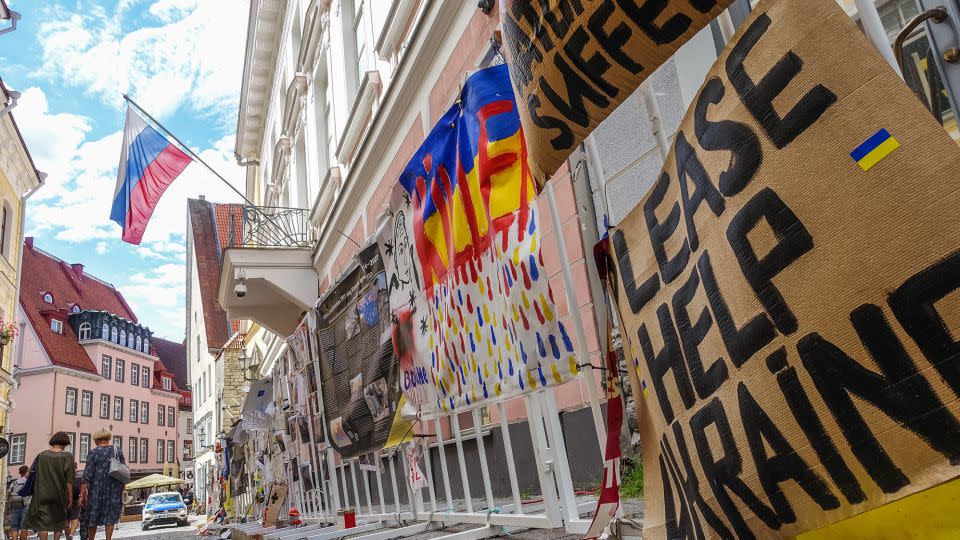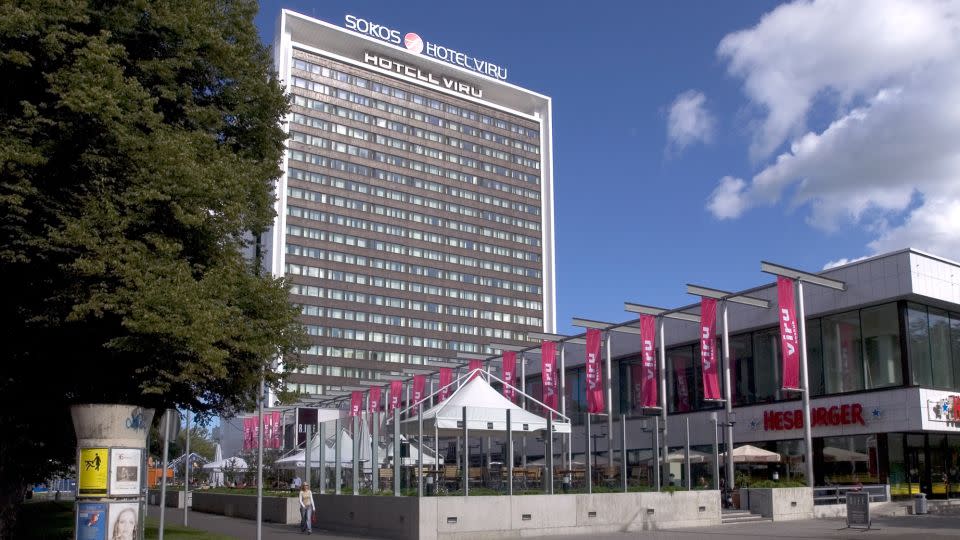Opinion: Russia’s neighbors have a message for Putin
- Oops!Something went wrong.Please try again later.
Editor’s Note: Frida Ghitis, a former CNN producer and correspondent, is a world affairs columnist. She is a weekly opinion contributor to CNN, a contributing columnist to The Washington Post and a columnist for World Politics Review. The views expressed in this commentary are her own. View more opinion on CNN.
Just below the surface of life’s deceptively normal rhythms in countries bordering Russia, the reality of what their giant neighbor is doing to Ukraine is never far away.

And it’s not only because Russia’s border stands nearby, or because Russia’s president has suggested that, just as Moscow had a right to take over Ukraine, it could be justified in reclaiming the Baltic states — Estonia, Latvia and Lithuania — which spent decades under Soviet rule.
More than anything, the anxiety flows from the knowledge, from the memory, that Moscow has sent its tanks into its neighbors’ territories so many times over the years.
Now, chapters that they thought had been safely relegated to the pages of history have taken on the menacing tint of reality.
Ukrainian President Volodymyr Zelensky put it bluntly on Monday, when he thanked Denmark for pledging to provide Ukraine with F-16 fighter jets, which the Netherlands also agreed to give Ukraine. “All of Russia’s neighbors are under threat,” he said, “if Ukraine does not prevail.” He will find few who disagree among those neighbors.
“If [Russian President Vladimir] Putin wins in Ukraine, they will come here,” I was told in Latvia by Raivis, who works as a driver in Riga, the capital, but asked me not to use his full name. He remembers standing in the barricades as a teenager, joining the struggle for independence three decades ago. “Now Putin wants to make the Soviet Union again,” he said.
It’s a widely held belief. It’s why Estonian Prime Minister Kaja Kallas, one of the most eloquent proponents of the need to support Ukraine, says Ukraine is Estonia’s own front line. “Ukraine,” she argues, “is fighting for all of us.”

Through the winding cobbled streets of old Tallinn, the Estonian capital, the fairy tale gothic landscape suddenly turns jarring on Pikk Tanav (or “Long Street” in English). Here, the exterior of Russia’s embassy has become a showcase for the contempt Estonians feel for their former master. Homemade signs demand that Russia “Stop killing children,” in a long line of messages, photographs of Ukraine’s carnage, splashes of bloodied hands and grotesque images of Putin.
The contempt is also on display in Riga, where authorities named the previously unnamed street where Russia’s majestic Art Nouveau embassy stands: “Ukraine Independence Street.” When they gaze at the window, Russian diplomats have a direct view of a sea of Ukrainian flags, along with signs calling Russia a “terrorist state,” among other choice words.
Latvia’s bravado is made possible by the safety of belonging to NATO. And NATO’s vast response to Russia’s invasion — vast streams of armament and unequivocal diplomatic backing to Ukraine — has made possible that sense of normalcy, however superficial. “Seeing all the support that Ukraine has received from NATO has calmed us down about an immediate threat,” Janis Melnikovs, the Latvia director for the Catholic broadcaster Radio Maria, told me, while sipping coffee on the edge of Riga’s old town, as musicians nearby rehearsed for that evening’s celebrations of the city’s 822nd anniversary.
But even now, Melnikovs says, with domestic economic concerns weighing on minds a year-and-a-half into the war and many, especially the elderly, straining under high levels of inflation that some link to support for Ukraine and a growing military budget, there’s still passionate support for Ukrainians here. The sentiment is visible across the region, where bright yellow and blue Ukrainian flags fly from building after building.
It’s also visible in Finland, with its 800-mile border with Russia — where the Kremlin also launched an invasion from 1939 to 1940, and ended up keeping a piece of territory. After decades of seeking safety in non-alignment, Russia’s invasion of Ukraine convinced Helsinki that neutrality offered no protection, so Finland, too, joined NATO in April.
Some 18 months after Russian forces tried to take Kyiv, signs at Helsinki’s airport still offer “Information for People Fleeing Ukraine.” And high above the central railway station still flies Ukraine’s familiar flag.
But it is the tiny Baltic states where the trauma of Stalin’s incursions and the subsequent subjugation to the Kremlin are still raw.

During Soviet times, the top floor of Tallinn’s Hotel Viru was off-limits to all but the KGB agents who used it to spy on foreign guests and local staff. Fleeing in 1991, agents left behind surveillance equipment, transmitters and microphones hidden in ashtrays and lamps.
For years, Margit Raud has been guiding tours of the frozen-in-time offices. Until recently, she said, everyone viewed them as a historic curiosity, a travesty. Now, she says, since Russia invaded Ukraine, it has all taken on a new seriousness.
Like most families in the Baltics, Margit has stories. Her grandmother was imprisoned and deported by the Stalinist regime for a dozen years over a trivial violation; her mother raised without her. Years later, Margit joined the revolution to free Estonia.
Latvia, too, has its own grim reminder of the KGB’s sinister hand. The so-called Corner House at Riga’s Brivibas Street 61, may seem another in Riga’s spectacular collection of ornate buildings. But in sharp contrast to their beauty, this one is a repository of repression and brutality. It is here that those suspected of “counterrevolutionary activity” — which might include writing poetry or not reporting purportedly counterrevolutionary activities by their neighbors, co-workers, friends and relatives — were brought in for interrogation, torture and even execution.
As in Estonia, Russia’s 21st century assault on Ukraine brought echoes of Russia’s 20th century subjugation of Latvia.
For years, Baltic leaders tried to warn their NATO allies that Russia posed a threat. As far back as 2007, Estonia became one of the first countries targeted by a massive cyberattack. Authorities there had removed a 1947 monument honoring the Soviet Army as World War II liberators of Tallinn. The decision sparked protests by Russian speakers, and before long, Estonia’s internet became mysteriously paralyzed.
Government offices, banks, newspapers, everything ground to a halt, some of it for weeks, after an attack from IP addresses based in Russia. It was a preview of a new type of warfare. No definitive culprit has been found, but even though Russia denies involvement, the Kremlin’s subsequent hacking incidents undercut those denials.
Many here viewed the crisis as a warning from the Kremlin. And when Russian forces entered the Republic of Georgia in 2008, and later invaded and annexed the Crimean Peninsula from Ukraine in 2014, they sounded the alarm. But not everyone heeded their warnings.
The Baltics take little comfort in having been proven right with their predictions, and they are offering much more than moral support and flag waving.
The top three contributors to Ukraine’s defense since Russia invaded, as a percentage of GDP, are Estonia, Latvia and Lithuania. Proportionally, Estonia’s aid is four times higher than the US’s. In addition, they’re sharply boosting their own defense spending
As the war drags on, the cost is taking its toll. There have been tensions with the large Russian-speaking minority. Language is a major issue across former Soviet territories, since the Soviets deliberately relocated hundreds of thousands of Russian speakers to dilute national identities, and Putin has exploited tensions, using them to acquire influence and justify military interventions.
The Baltics have also become home to tens of thousands of Ukrainian refugees, who nervously watch developments back home — and in the US. Galina Domenikovska, 53, sells almonds at a street stand in Tallinn. When I told her I come from the US, she glanced toward the heavens and put her hands together. “Best, wonderful country,” she told me in broken English. She typed a message into her phone and translated it, thanking Americans for supporting Ukraine. Then typed another for President Joe Biden, wishing him health and long life.
When I asked her about former President Donald Trump, she winced, and told me she is afraid he will come back to office.
Russia’s full-scale invasion of Ukraine has reawakened old fears and breathed new life into the commitment for self-determination in a region that thought it had already won those battles and put away history’s ghosts.
Genuine normalcy, a permanent sense of safety, Russia’s neighbors have discovered, will have to wait until peace returns to a secure Ukraine.
For more CNN news and newsletters create an account at CNN.com

